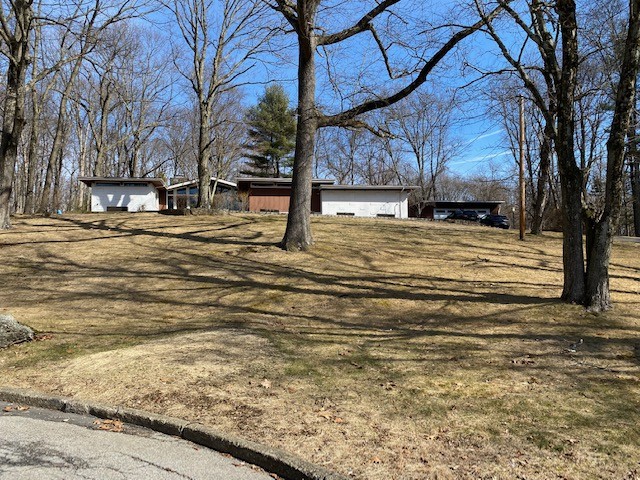This entry includes a walking tour! Take the tour.
Introduction
Text-to-speech Audio
The Robinwood Historic District consists of 21 mid-century Modern houses erected as the centerpiece of a unified housing development in the mid-1960s in the Town of Ossining, Westchester County, New York. The houses which form this cohesive mid-twentieth century housing enclave were designed by architect Harry Wenning, a New Jersey native who was educated at the College of William & Mary and subsequently at the Massachusetts Institute of Technology, where he earned a degree in architecture in 1952.The Robinwood Historic District was placed on the National Register of Historic Places in 2019.
Images
30 Taverno Road

Backstory and Context
Text-to-speech Audio
The Robinwood Historic District is an architecturally significant and highly intact housing development consisting of a related group of mid-century Modern houses erected in the 1960s in the Town of Ossining, NY. This noteworthy developer-architect collaboration resulted in the construction of 21 dwellings, the design and setting of which was conceived as an optimal suburban community. The district was conceived and built by architect Henry Wedding during a period in which developers wee more inclined to construct houses of the ranch, split-level and traditional types.
For the Robinwood houses, Wenning authored designs which were stylistically contemporary and well-integrated with their immediate site and natural surroundings; all featured signature design features such as open floor plans, clerestory windows, the extensive use of wood, and large glazed expanses. Few houses exhibiting such Modern architectural tendencies characteristic of the post-Second World War era were constructed in the town of Ossining, marking this collection as all the more distinctive, particularly since they were built as a cohesive group and thus constitute an interrelated architectural experience. The first four houses were completed in 1965. Six followed in 1966, and five more were completed in 1967. By 1968 all of the Robinwood development houses except one which was finished in 1969, had been erected. The houses were initially sold at prices ranging from $40,000 to $70,000.
The nominated historic district is organized around the L-shaped spine of Tavano Road, which extends eastward from Somerstown Road and which is bordered in large measure by thickly wooded undeveloped land; while the various houses within the district feature relatively uniform setbacks from the road, their relationship to the physical traits of their individual parcel, and not their relationship to other adjacent houses, was the critical factor in the manner in which they were sited and oriented. The topography within the district is naturally undulating; as such, many of the houses are elevated on rises of land above the level of the roadway; these various properties feature landscape elements such as grassy lawns, mature deciduous and coniferous trees, and ornamental plantings.
Wenning’s Robinwood houses, characterized by their straightforward geometric massing, post-and-beam construction and large window expanses, maximized the interaction between the house and landscape and lends them one of their foremost and most enduring qualities. These houses incorporated the best qualities necessary for efficient and economical construction with a design aesthetic that reads as clearly today as when the dwellings were constructed.
The Robinwood Historic District remains largely as it was when first completed: an intact, cohesive and significant collection of mid-century Modern dwellings erected as part of a comprehensive development scheme within a naturally landscaped enclave. The nominated district contains a total of 22 contributing buildings—21 houses built to Welling’s design and one which was modified from an existing house constructed ca. 1920. There are no non-contributing principal resources located within the district boundary.
Sources
- “Robinwood Historic District #100003632.” National Register of Historic Places. United States Department of the Interior/National Park Service.
- Roger Panetta, Westchester the American Suburb, New York, Fordham University Press, 2006.
- The Hastings News, "Wenning's Architectural Range: The Simplex, Duplex or Complex, " 7 April 1966.
